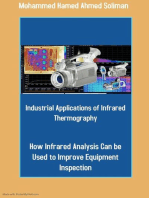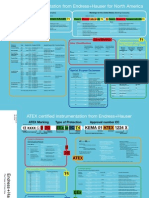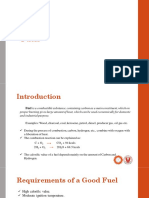Atex Tools
Atex Tools
Uploaded by
Amine GuettatCopyright:
Available Formats
Atex Tools
Atex Tools
Uploaded by
Amine GuettatOriginal Description:
Copyright
Available Formats
Share this document
Did you find this document useful?
Is this content inappropriate?
Copyright:
Available Formats
Atex Tools
Atex Tools
Uploaded by
Amine GuettatCopyright:
Available Formats
ATEX- Tools ((Atmospheres Explosibles))
Equipment applied in explosive areas involves a high risk.
Explosive atmospheres can be caused by flammable gases, mists or vapours or by combustible dusts. If there is enough of the substance, mixed with air, then all it needs is a source of ignition to cause an explosion.
Since 1st of July 2003 the new EC directive 94/9/EC (ATEX 95) has become effective. This is achieved by harmonizing the legal safety precautions according to a risk depending methodology.
Our tools are classified according to the ATEX product directive 94/ 9 EG (unofficially known as "ATX 95").
Explosiv atmosphere
is defined - in terms of the directive 94/9/EC - as a mixture of dangerous substances with air, under atmospheric conditions, in the form of gases, vapours, mist or dust in which, after ignition has occurred, combustion spreads to the entire unburned mixture.
Explosion protection measures
In order to select the appropriate measure, an explosion protection concept has to be developed for each individual case. This has to refer to
a. Work equipment, like machines, systems, tools and devices (ATEX 95 - directive 94/9 EC for operation consumables (manufacturer)) and
b. Work place and work environment (ATEX 137 - directive 1999/92 EC operation of facilities (operator))
and it has to be applied consistently.
ATEX 95 ( directive 94/9 EG for operation consumables (manufacturer))
The ATEX 95 classifies groups, zones and classes.
Depending on the application, a distinction is made between equipment group I (use in mining/ underground mining) and equipment group II (us in other explosive areas)
Equipment group I
-use in explosive areas of underground mines, including their surface devices
Equipment group I
Equipment used in mining/ underground mining
Category M1 Category M2
Requirement very high degree of safety high degree of safety
Equipment group II
- use in other explosive areas
- very high degree of safety
- if a safety measure of an device fails, a second independent safety measure must ensure the required safety
- high degree of safety
- the explosion protection has to work in a way, that the required safety is ensured as well in case of device errors, which usually have to be expected
- a sufficient degree of safety
A tool of category 1 with very high safety requirement includes the lower categories 2 and 3.
Equipment group II
Equipment for use in other explosive areas
Category 1 Category 2 Category 3
Danger always, often or for a longer period of time occasional rare and for short time
Requirement very high degree of safety high degree of safety normal degree of safety
Zone 21
Zone Zone 0 (1, 2) Zone 20 (21, 22) Zone 1 (2) Zone 2 Zone 22
(22)
Substance group G (Gas) D (dust) G (Gas) D (dust) G (Gas) D (dust)
Temperature classification
The approved surface temperatures are divided in 6 temperature classes (T1- T6). Furthermore a classification of combustible gases and vapours (dusts) and their ignition temperatures is possible.
The given temperature is the maximum permissible surface temperature at the tool. Operation consumables approved for the temperature class T6, is automatically approved for the higher temperatures (T1- T5)
Max. Ignition temperatures of some
Temperature class
surface temperature substances for comparison
Propane gas 510 °C, natural gas 650
T1 450 °C
°C
T2 300 °C Acetylene 305 °C, Diesel fuel 310 °C
T3 200 °C Benzine 260-450 °C
T4 135 °C Ether 170 °C
T5 100 °C Hydrocarbon 102 °C
T6 85 °C White phosphorous 60 °C
ATEX 137 ( directive 1999/92 EG operation of facilities (operator))
The ATEX operation directive 1999/ 92/ EG (unofficially known as "ATEX 137) refers to the minimum requirements for the improvement of the health protection and the safety of workers,
which could be endangered by the explosive atmosphere.
In 2002 this directive was transponed into German, respectively Austrian, legislation in the scope of the German Plant Safety Ordinance respectively by the Ordinance Explosive Atmospheres (VEXAT).
This guide line contains basic safety requirements which have to be met by the operator/ employer. This includes:
- Avoidance or reduction of the formation of explosive atmosphere (primary explosion protection)
- Avoidance of effective ignition sources (secondary explosion protection)
- Limitation of the effect of a probable explosion to a harmless level (tertiary or constructive explosion protection)
In the scope of his risk assessment, the employer has to create an explosion protection document and he has to divide areas with dangerous explosive atmosphere into zones.
You might also like
- ATEXDocument2 pagesATEXvypatilNo ratings yet
- Industrial Applications of Infrared Thermography: How Infrared Analysis Can be Used to Improve Equipment InspectionFrom EverandIndustrial Applications of Infrared Thermography: How Infrared Analysis Can be Used to Improve Equipment InspectionRating: 4.5 out of 5 stars4.5/5 (3)
- CAT M316D MaintenanceDocument66 pagesCAT M316D MaintenanceHenwy Dickinson75% (4)
- ATEX Explained: The Explosion Protection RegulationsDocument4 pagesATEX Explained: The Explosion Protection RegulationsenviroashNo ratings yet
- MAXON PresentationDocument27 pagesMAXON PresentationJaroslav KurucNo ratings yet
- Environments and Standards - The ATEX Standard - Petzl PDFDocument3 pagesEnvironments and Standards - The ATEX Standard - Petzl PDFtintucinbNo ratings yet
- ATEX - IECEX Training PowerpointDocument81 pagesATEX - IECEX Training PowerpointMott GirouardNo ratings yet
- Hazardous Area GuideDocument8 pagesHazardous Area GuideedwinNo ratings yet
- Explosion-Proof KnowledgeDocument4 pagesExplosion-Proof KnowledgeEra SutrajayaNo ratings yet
- Norma AtexDocument4 pagesNorma AtexV_VicNo ratings yet
- DSEAR RM Technical2Document2 pagesDSEAR RM Technical2Anonymous bHh1L1No ratings yet
- Atex ExplainedDocument3 pagesAtex ExplainedReyes SanchezNo ratings yet
- Basics of Explosion Protection - IecDocument4 pagesBasics of Explosion Protection - IecbenounaomarNo ratings yet
- Handouts - Engineering Procedures in Hazardous Atmospheres in Power PlantsDocument15 pagesHandouts - Engineering Procedures in Hazardous Atmospheres in Power PlantsDavid Luna MolinaNo ratings yet
- Hazardous Areas: Gases and VapoursDocument10 pagesHazardous Areas: Gases and VapoursShah JayNo ratings yet
- AtexDocument2 pagesAtexmousypusaNo ratings yet
- Hazardous Area ZonesDocument8 pagesHazardous Area ZonessiddharthangandhiNo ratings yet
- En Atex BrochureDocument12 pagesEn Atex BrochureAntony MylvaganamNo ratings yet
- Atex ExplainedDocument3 pagesAtex ExplainedErica LindseyNo ratings yet
- ATEXDocument1 pageATEXselvan110663No ratings yet
- KTR ATEXDocument16 pagesKTR ATEXIvano VerbiNo ratings yet
- Flametec Data SheetDocument1 pageFlametec Data SheetDang Ngoc PhuNo ratings yet
- ATEX Markings ExplainedDocument5 pagesATEX Markings Explainedritu sinhaNo ratings yet
- Atex Markings ExplainedDocument5 pagesAtex Markings ExplainedBaba JohnehNo ratings yet
- Hazardous Areas Are Defined by Three Main CriteriaDocument10 pagesHazardous Areas Are Defined by Three Main CriteriaviddyadrianNo ratings yet
- KTR Kat99ep05Document16 pagesKTR Kat99ep05Ivano VerbiNo ratings yet
- Hazardous AREA ClassificationDocument10 pagesHazardous AREA Classificationfarzam100% (1)
- Understanding Hazardous Area Classification PDFDocument7 pagesUnderstanding Hazardous Area Classification PDFNaveed IrshadNo ratings yet
- ATEX Markings ExplainedDocument6 pagesATEX Markings Explainedceca celsaNo ratings yet
- ATEX Handout PDFDocument7 pagesATEX Handout PDFArif KhanNo ratings yet
- ATEX Handout PDFDocument7 pagesATEX Handout PDFEhsan RohaniNo ratings yet
- Hazardous Area BasicsDocument10 pagesHazardous Area BasicsDig ChauhanNo ratings yet
- EXPLOSIVE CLASSIFICATIONS ATexDocument5 pagesEXPLOSIVE CLASSIFICATIONS ATexJeet SinghNo ratings yet
- Haz Area ClassificationDocument8 pagesHaz Area ClassificationBalasubramanianNo ratings yet
- ATEX Groups and ZonesDocument11 pagesATEX Groups and ZoneskejujuranNo ratings yet
- GXXE eDocument14 pagesGXXE ejo4ubvNo ratings yet
- ATEX Explosive AtmospheresDocument3 pagesATEX Explosive AtmospheresrakicbgNo ratings yet
- Hazardous Area ClassificationDocument23 pagesHazardous Area ClassificationDattatray Nikam100% (11)
- WEG W21Xdb Flameproof Motors 50100581 Brochure English WebDocument16 pagesWEG W21Xdb Flameproof Motors 50100581 Brochure English WebChrist Rodney MAKANANo ratings yet
- Hazardous Areas Are Defined by Three Main CriteriaDocument5 pagesHazardous Areas Are Defined by Three Main Criteriaswarm62No ratings yet
- Redapt Hazardous Area GuideDocument11 pagesRedapt Hazardous Area Guidescribd8421100% (1)
- Redapt Hazardous Area GuideDocument11 pagesRedapt Hazardous Area GuidekarthipetroNo ratings yet
- ATEX - UnderstandingDocument7 pagesATEX - UnderstandingpintileirobertNo ratings yet
- Electrical Equipment in Hazardous AreasDocument8 pagesElectrical Equipment in Hazardous AreasMehulkumar PatelNo ratings yet
- General Principles of Explosive Atmosphere - PresentationDocument160 pagesGeneral Principles of Explosive Atmosphere - PresentationDinuNo ratings yet
- Equipment For CA (Final)Document36 pagesEquipment For CA (Final)alejandro sanchezNo ratings yet
- CompEx Summary of Keypoints (Feb2023) - Batam (English - Indonesia)Document40 pagesCompEx Summary of Keypoints (Feb2023) - Batam (English - Indonesia)Kurniadi SetyantoNo ratings yet
- Poster Areas ClassificadasDocument1 pagePoster Areas ClassificadasYuri WentzcovitchNo ratings yet
- COM ATEX Poster EN PDFDocument1 pageCOM ATEX Poster EN PDFWerner SchulzNo ratings yet
- Clasificacion de Enclosures Nema Ip AtexDocument5 pagesClasificacion de Enclosures Nema Ip AtexJORGE ALBERTO PEREZ RAMIREZNo ratings yet
- At ExDocument2 pagesAt ExMoustafa Ibrahim YehyaNo ratings yet
- Ex Motor PresentationDocument72 pagesEx Motor PresentationsanatikalaNo ratings yet
- Management of Depleted Uranium Used as Shielding in Disused Radiation DevicesFrom EverandManagement of Depleted Uranium Used as Shielding in Disused Radiation DevicesNo ratings yet
- Management of Disused Ionization Chamber Smoke Detectors: Approaches and Practical ExperiencesFrom EverandManagement of Disused Ionization Chamber Smoke Detectors: Approaches and Practical ExperiencesNo ratings yet
- Dust Explosion and Fire Prevention Handbook: A Guide to Good Industry PracticesFrom EverandDust Explosion and Fire Prevention Handbook: A Guide to Good Industry PracticesNo ratings yet
- Occupational Radiation Protection in the Uranium Mining and Processing IndustryFrom EverandOccupational Radiation Protection in the Uranium Mining and Processing IndustryNo ratings yet
- Datasheet VDZC en PDFDocument4 pagesDatasheet VDZC en PDFMartin KratkyNo ratings yet
- 2017 August 07, Dipesh Patel, Ijteri, Vol 1, Issue 11, August 2017Document3 pages2017 August 07, Dipesh Patel, Ijteri, Vol 1, Issue 11, August 2017Srinath SamagaNo ratings yet
- Bituminous MaterialsDocument12 pagesBituminous MaterialsBella AbellaNo ratings yet
- Unit 22 - Module3 FINALDocument116 pagesUnit 22 - Module3 FINALbkctsdNo ratings yet
- Mce320 Tutorial KitDocument20 pagesMce320 Tutorial KitxentrixxNo ratings yet
- Lecture 7 FuelsDocument50 pagesLecture 7 FuelsRed BilbitNo ratings yet
- About Nova Chemical ProjectDocument29 pagesAbout Nova Chemical ProjectrajeshpuriNo ratings yet
- DCC EngDocument1 pageDCC Engwahaha06No ratings yet
- Eca Day Tank SpecDocument3 pagesEca Day Tank Specenlightened1718No ratings yet
- Refill Capacities and RecommendationsDocument5 pagesRefill Capacities and RecommendationssxturboNo ratings yet
- Delayed Coking PDFDocument21 pagesDelayed Coking PDFAnonymous j5XYgIuNo ratings yet
- Re RefiningDocument68 pagesRe RefiningBibhu PratapNo ratings yet
- Ácido Sulfurico Ligas CompatíveisDocument2 pagesÁcido Sulfurico Ligas CompatíveisGuilherme Augusto de OliveiraNo ratings yet
- Hot Work PermitDocument2 pagesHot Work Permitkumar kannanNo ratings yet
- Energy Companies in TrinidadDocument8 pagesEnergy Companies in TrinidadLyndon RamasarNo ratings yet
- 2000 KVA Caterpillar 3516 Gen Set Data SheetDocument8 pages2000 KVA Caterpillar 3516 Gen Set Data SheetMohamed Hamdallah100% (1)
- Catalytic Cracking: Gautam Prasad DewanganDocument18 pagesCatalytic Cracking: Gautam Prasad DewanganGlenPalmerNo ratings yet
- Introduction AcetoneDocument1 pageIntroduction AcetonePamela Angela YabutNo ratings yet
- Properties of Various Ideal Gases (At 300 K)Document1 pageProperties of Various Ideal Gases (At 300 K)ZizuNo ratings yet
- General Engine D20DT PDFDocument135 pagesGeneral Engine D20DT PDFmanual100% (1)
- Damage ControlDocument55 pagesDamage ControlKaan Duymaz100% (1)
- Mixed Refrigerant ProcessDocument2 pagesMixed Refrigerant ProcessWade ColemanNo ratings yet
- Genset Load TestDocument10 pagesGenset Load Testjavad100% (2)
- LPG Technical Cod enDocument83 pagesLPG Technical Cod enZecheru100% (1)
- CL 351: Chemical Engineering Lab IIDocument9 pagesCL 351: Chemical Engineering Lab IIsagarchawla13No ratings yet
- Fire Protection SystemDocument38 pagesFire Protection SystemAngelika Lei Garao100% (1)
- 2011 AEBIOM Annual Statistical ReportDocument108 pages2011 AEBIOM Annual Statistical ReportJohan HaatajaNo ratings yet
- Kubota z723 Mower Operators ManualDocument95 pagesKubota z723 Mower Operators Manualjimmyboy111100% (1)
























































































